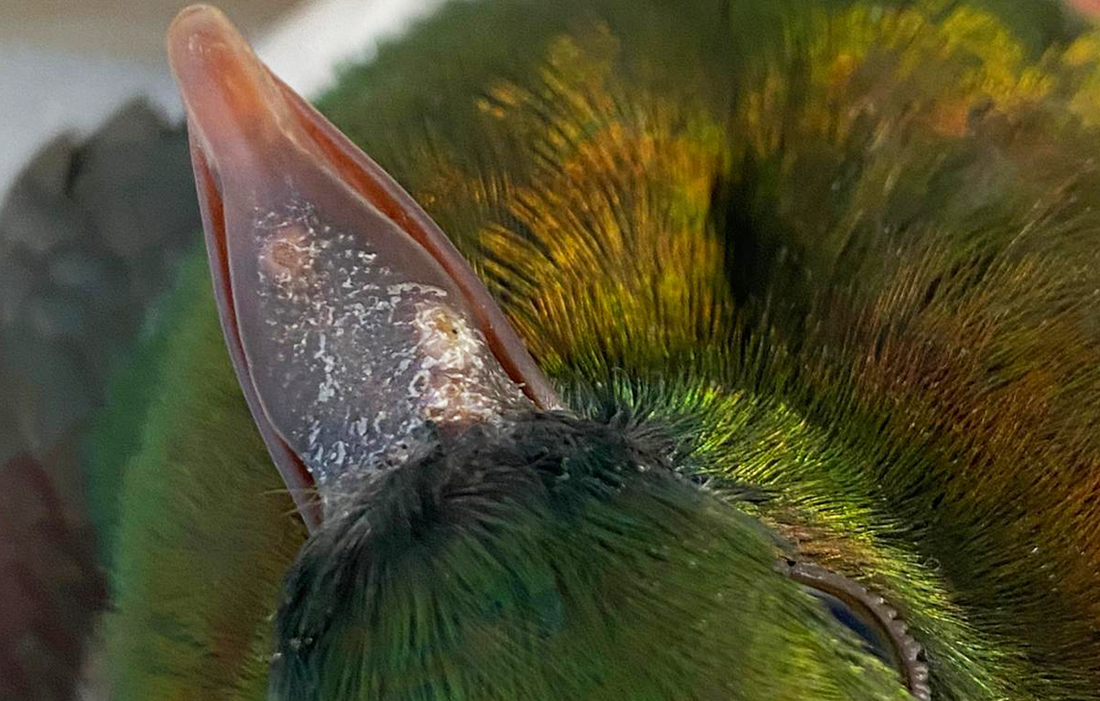
Avian Pox
Share
Avian Pox is a common disease seen in many countries around the world. Of the 9,000 bird species known there are 232 of them that have developed a natural pox virus infection. A great deal of host specificity exists with this virus in that one species of bird with pox cannot infect another species in most cases. In the cases where the virus can jump species the clinical signs tend to not occur or be so slight as to not be noticed. That means that pox for a magpie would not infect a pigeon or chicken.


Photo: Young kereru with pox lesions developing on face and feet.
Pox virus tend to occur in areas where bird populations are high such as backyard flocks, farms, lofts or nesting sites. Transmission is mechanical in that a bird tends to have to injure or scratch itself before the virus can penetrate. Most pox viruses for birds require a small skin laceration or puncture in order to be effective. Insects such as flies, mites and mosquitoes can also pass the virus during blood feeding. The dried scabs of the pox lesion are infected with the virus can be aerosolized in the dust leading to infection of the laryngeal cavity. The tissue in the mouth appears to be very susceptible to viral infection with infections occurring here without wounds or scratches. From exposure to disease the incubation period is about 4 to 10 days with the lesions lasting for 1 to 5 weeks. After this time the bird will be immune from additional infections for the remainder of it’s life.
There are no cures for the pox virus currently and vaccines are only available in commercial sizes for poultry, which makes their access to the public very impractical.

Photo: Adult shaver chicken with severe pox lesions on her face.
There are two basic forms of lesions:
1) Cutaneous form: Nodular lesions on the comb, wattle, eyelids and other non-feather areas of the skin. These lesions often scab over and can disrupt normal tissue function and blood supply leading to localised necrosis in some cases and compromising function of things like feet, beaks and eyes.
2) Wet form: In the oral version a yellowish “canker” or diphtheric membrane is formed and can interfere with breathing, drinking and eating. Removal of the lesion often results in extensive bleeding.
3) There is also a systemic form that is quite rare and documented in only Canaries but the two main forms can occur together.

Secondly comes Supportive Care. Managing the feeding and watering of your affected bird is important as the ability to find and consume food can be limited. Setting up a hospital pen and monitoring food and water intake, as well as droppings, will give you a good idea of how much they are eating and if they stop or decrease their intake. Things like pain relief, soothing ointment for the lesions and often some prescribed antibiotics to help with secondary infections are needed for the best care. If lesions look to compromise some organs such as eyes and beaks or restrict breathing, additional veterinary help is required. In the worst cases euthanasia needs to be considered.
Vitamin E can be supplemented to the feed to aid in skin repair as well as wound sprays if lesions become infected.
Note: If you are treating a pox patient in hospital, biosecurity (quarantine) is very important for the health of your other patients. Pox shed the most virus during the scabbing phase. Severity of pox is dependent on viral load, secondary infections and immune status of the patient.
For more information, check out the links below.
The Australian Pigeon company
https://www.msdvetmanual.com/poultry/fowlpox/pox-infections-in-birds-other-than-chickens-and-turkeys

